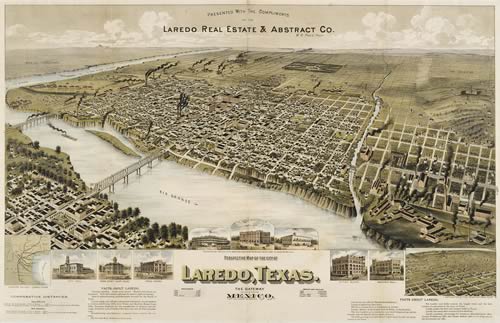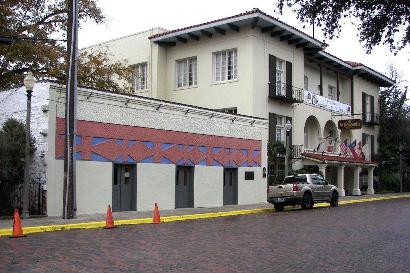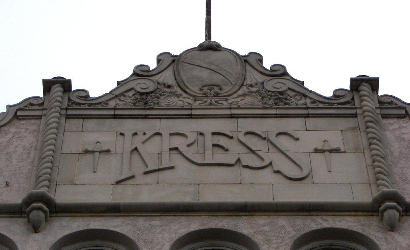Laredo, Texas, Webb County seat . (original) (raw)
Webb County Seat, South Texas
27� 31' 28" N, 99� 29' 26.14" W (27.524445, -99.490593)
I-35
Hwys 59, 83, and 359
On the Rio Grande
134 miles NW of McAllen
150 miles SW of San Antonio
ZIP Codes 78040�78046, 78049
Area code 956
Population: 263,640 (2020)
236,091 (2010) 176,576 (2000) 122,899 (1990)
Book Hotel Heree › Laredo Hotels
Laredo, Texas 1892 Perspective Map
The Gateway to and From Mexico, 1892
Click on image to enlarge
Wikicommons
History in a Pecan Shell
Laredo was established in 1755 as part of the province of Nuevo Santander. It was only one of many towns and missions built in a grand attempt at keeping the French out of the region.
The early settlers found that there was an insuffcient amount of rainfall for anything other than river bottom farming. Land was too high above the river for irrigation.
Until Laredo was accorded the status of villa in 1767, fifteen leagues of land granted to the community were held in common. Colonists, understandably, were reluctant to make improvements on land not theirs.
In 1767 a commission oversaw the partitioning of public lands in Nuevo Santander. This commission supervised the laying out of San Agust�n Plaza and the common areas of the town. The first election for local officials was held in 1768.
The population was 85 in 1757, and 708 in 1789.
As ranches in the region became prosperous, however, raids by Indians became a serious concern.
During the Texas Revolution Laredo was what is now called a logistical support center for Santa Anna's invading army. Even after the war, residents of Laredo still considered themselves citizens of Mexico (forgotten and neglected citizens, but citizens nonetheless). The Texans didn't concern themselves with the area at all.
In late 1838 the ranch owners of the region revolted, and in January 1840 the Republic of the Rio Grande was proclaimed with Laredo as capital. The proclamation got Mexico City's attention and forces were sent to reclaim it.
Laredo remained somewhat independent until the Mexican War. In 1846Texas Ranger Robert Gillespie raised the U. S. flag over the city, and an American garrison later occupied the town.
In 1848 Laredo became county seat for Webb County. A number of families chose to move across the river to what became Nuevo Laredo.
Laredo's modern era began in 1881 when two railroads entered Laredo. The Texas Mexican Railroad connected the town to Corpus Christi, and the International and Great Northern Railroad went to San Antonio.
A few years later the Mexican National Railway linked Nuevo Laredo with Mexico City (1887) creating an important rail link with the Mexican capital.
The railroads brought in Anglo settlers in large numbers. Intermarriage, which had been a common practice, declined and separatism became the order of the day.
In 1882 streets were improved and a city hall and courthouse were constructed.
The population of Laredo increased from 3,500 in 1880 to 13,500 in 1900.
During World War II Laredo Army Air Field was a training facility for fighter pilots. After the war it was deactivated and became the city's airport in 1950. The base was reactivated in 52 during the Korean War as Laredo A.F.B. and was permanently closed in 1973.
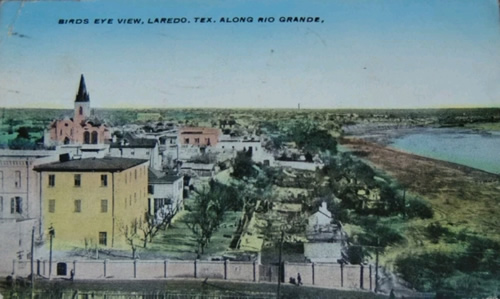
Laredo, Texas
Attractions & Landmarks
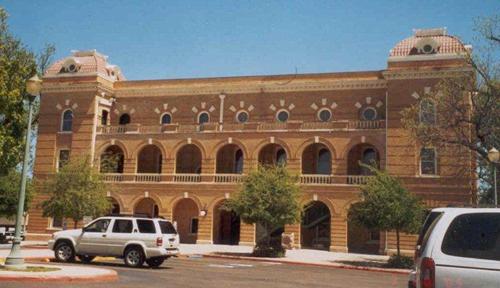
- Fort McIntosh - "Established by Army in 1848 immediately following Mexican War, fort was in continuous use until May, 1946. It was originally among series of border forts guarding against attacks and was base for border patrol. Laredo Community College now on grounds. ... The original earthen fort is now part of the Paso Del Indio Nature Trail. West End of Washington St. on banks of Rio Grande." - From TXDoT State Travel Guide
- Lake Casa Blanca - Off US Highway 59
Five miles northeast of Laredo - Lake Casa Blanca International State Park
5102 Bob Bullock Loop Laredo TX 78044
956/725-3826 - Lamar Bruni Vergara Environmental Science Center -
On Laredo Community College Campus.
West End Washington St.
Information - 956-764-5701. Admission - Laredo Center for the Arts - 500 San Agustin.
956-725-1715 - Laredo Children's Museum -
On Laredo Community College Campus.
West End Washington St.
956-725-2299. Admission - Nuevo Laredo, Mexico - Across the border.
Within walking distance from downtown Laredo. El Mercado marketplace is just two blocks from international bridge. - The Nuevo Santander Museum at Laredo State University
- Republic of the Rio Grande Building/Museum -
1000 Zaragosa St. South of San Agustin Plaza - San Augustin Cathedral - On San Agustin Plaza.
- Washington's Birthday Celebration Museum -
1000 Zaragosa St.
Memorabilia of Laredo's Washington's Birthday Celebration, an over century old tradition. - La Posada Hotel by Mike Cox ("Texas Tales" Column)
"...La Posada is one of the few hotels anywhere in the nation with two built-in museums. One, dedicated to the annual February birthday bash for the father of our country, has a collection of the ornate 100-pound gowns worn by various "Martha Washingtons" as well as the long coats and knee pants worn by generations of "George Washingtons."
The other museum, located in an 1830s-vintage structure that once served as the capital of the short-lived Republic of the Rio Grande, features exhibits and artifacts related to the 250-plus-year history of Laredo." - Laredo Hotels - Book Hotel Here
"The adobe building that served as the capital of the Republic of the Rio Grande (left) and the La Posada Hotel (right.)" -
Terry Jeanson, January 2013 photo
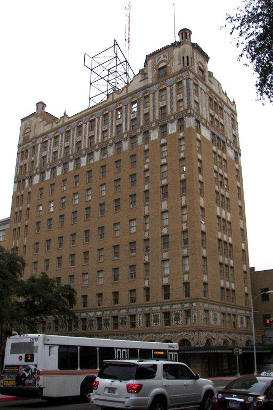
"The Hamilton Hotel. Built as a three story building in 1900 and expanded to a twelve story building in 1923. It is now used as a low income apartment building for elderly residents." -
Terry Jeanson, January 2013 photo


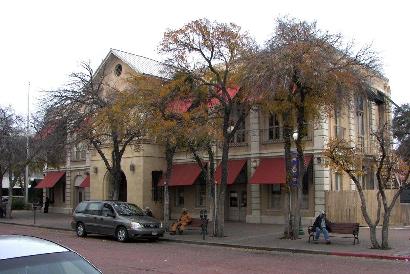
"Old Market House and City Hall on Flores St. between Hidalgo and Lincoln streets. It was built between 1883 and 1884. A large tower used to stand over the front entrance." - Terry Jeanson, January 2013
"The building is now used for the Webb County Heritage Foundation as well as the Laredo Center for the Art (through the back entrance on San Agustin Ave.) The Visitors' Bureau is across the street." Julia Orduna, December 1, 2016
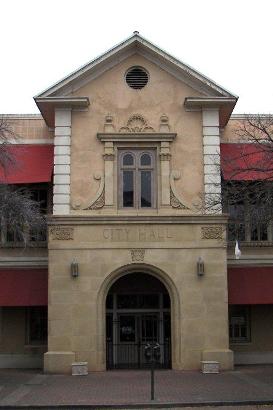
Detail of the front entrance to the old Market House and City Hall.
Photo courtesy Terry Jeanson January 2013

"The U.S. Court House, Post Office and Custom House on Matamoros St., built in 1907."
Terry Jeanson, January 2013 photo
Kress building at Covent Ave. & Hidalgo St.
Photo courtesy Terry Jeanson January 2013
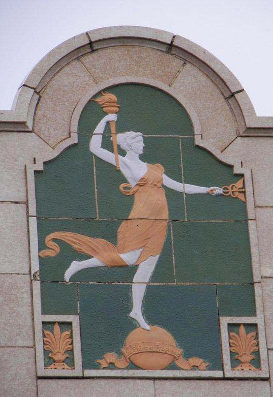
Montgomery Ward's "Spirit of Progress."
Photo courtesy Terry Jeanson January 2013

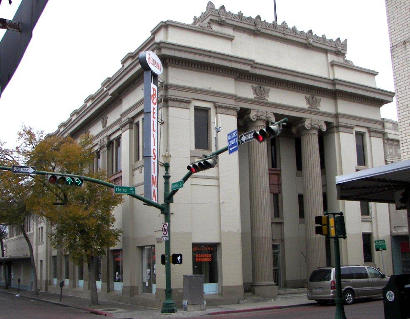
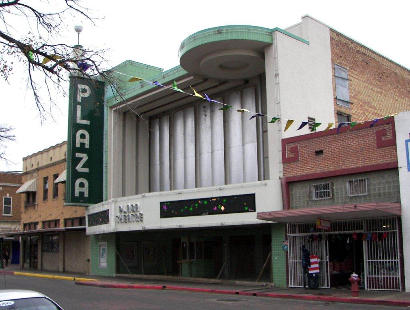
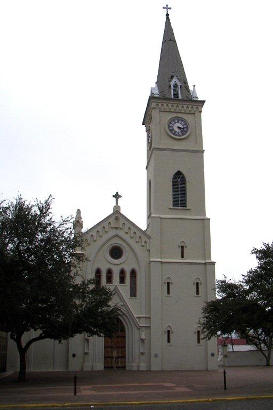
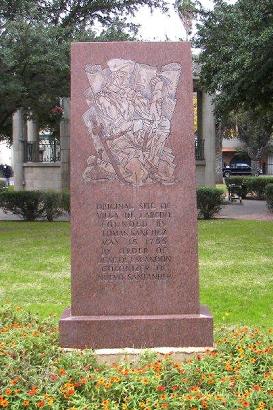
The marker across from the San Agustin Cathedral reads: "Original site of Villa de Laredo founded by Thomas Sanchez May 15 1755 by order of Jose de Escandon colonizer of Nuevo Santander."
Photo courtesy Terry Jeanson January 2013
More Texas Monuments
 |
Roberto Garcia Junior's 1990 statue of George Washington TE Photo More Texas Statues |
|---|
Laredo Tourist and Local Information
- Laredo Convention and Visitors Bureau - 800-361-3360
- The Laredo Chamber of Commerce:
2310 San Bernard,o Laredo, Texas 78402
Mailing address: P.O. Box 790 Laredo, Texas 78402
(956) 722-9895 or 1-800-292-2122
Website: http://www.laredochamber.com/ - The City of Laredo
website: http://www.thecityoflaredo.com/
Texas Travel Information Center - Operated by TXDoT
Information, maps, literature on Texas.
On I-35 North of Laredo, Off mile marker 18.
Laredo Hotels
- Book Here
1940s Webb County Texas map showing Laredo
Courtesy Texas General Land Office
Texas Escapes, in its purpose to preserve historic, endangered and vanishing Texas, asks that anyone wishing to share their local history, stories, landmarks and recent or vintage photos, please contact us.
